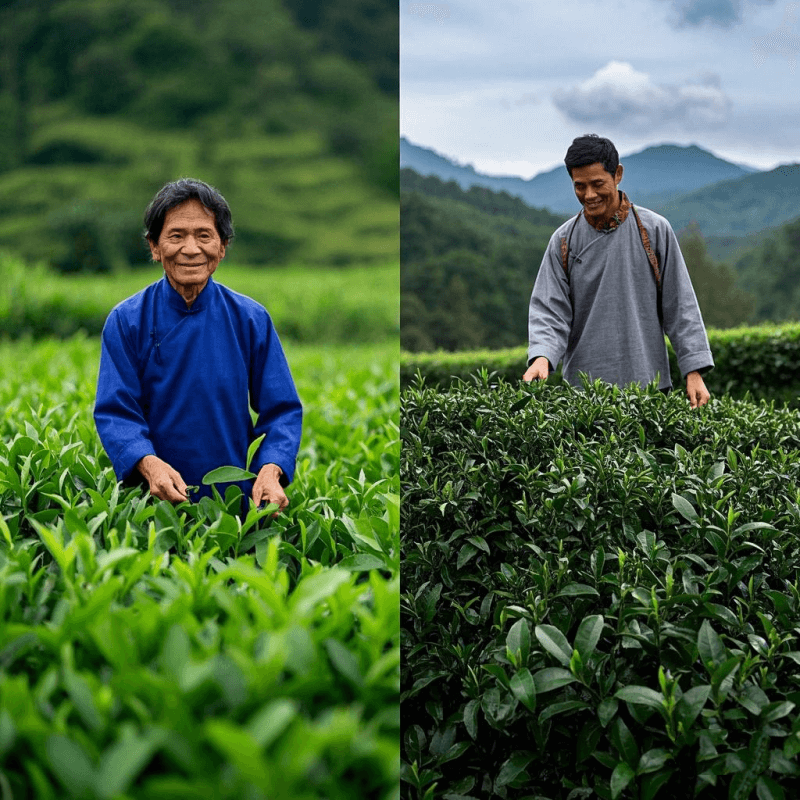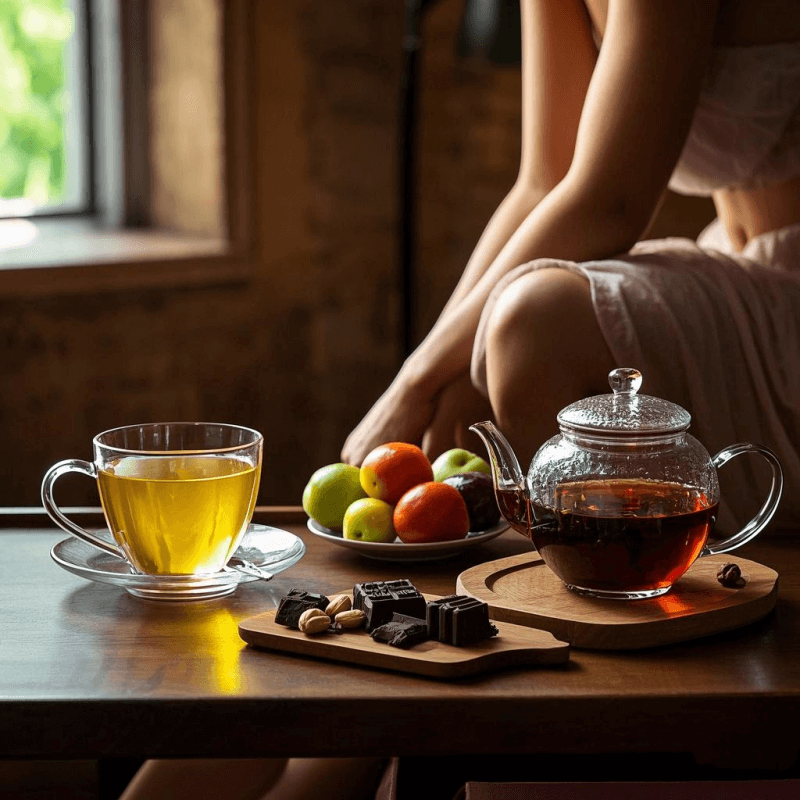is oolong green tea:

1. Introduction: Why Ask “Is Oolong Green Tea?”
The question “is oolong green tea?” often arises due to their shared origins in China and similar leaf appearances, but the answer reveals a fascinating world of tea diversity. A 2023 survey by Tea Insights Lab found that 63% of new tea drinkers confuse these two categories, highlighting the need for clarity. While both come from Camellia sinensis leaves, their processing paths diverge dramatically—one embracing partial oxidation, the other halting it entirely. This article unpacks their core differences in processing, taste, and health benefits, empowering you to choose the right brew for every mood and need.
2. What Is Oolong Tea? Origin, Oxidation, and Characteristics
Oolong tea is a semi-oxidized tea originating in China’s Fujian province over 400 years ago, later spreading to Taiwan and beyond. Unlike green tea’s rapid heat treatment to prevent oxidation, oolong tea undergoes a controlled oxidation process (10–80%), allowing enzymes to transform leaf compounds gradually. This creates a flavor spectrum unmatched by other teas:
Key Characteristics:
- Oxidation Range: 10% (lightly oxidized, e.g., Taiwanese Alishan) to 80% (heavily oxidized, e.g., Wuyi Rock Tea).
- Leaf Appearance: Rolled or twisted leaves in shades of greenish-brown to deep mahogany, depending on oxidation.
- Cultural Significance: Central to Chinese gongfu cha rituals, celebrated for its ability to be steeped 6–10 times, revealing evolving flavors.
As The Tea Enthusiast notes, oolong tea’s “in-between” status makes it a bridge between the freshness of green tea and the depth of black tea, appealing to diverse palates.
3. Is Oolong Green Tea? Key Differences in Processing and Appearance
The short answer: No, oolong is not green tea. Their primary distinction lies in how they handle oxidation, a chemical process that alters flavor, color, and aroma:
🔬 Processing Breakdown
| Aspect | Oolong Tea | Green Tea |
| Oxidation Level | 10–80% (controlled semi-oxidation) | <10% (oxidation halted immediately) |
| Key Step | Tossing/bruising leaves to initiate oxidation | Pan-frying/steaming to inactivate enzymes |
| Duration | Processing takes 2–3 days (including roasting for some) | Completed in hours (freshness-focused) |
👀 Visual Differences
- Dry Leaves: Oolong tea leaves are often larger, more twisted, and range from jade green (light oolongs) to dark brown (roasted varieties). Green tea leaves are smaller, flatter, and uniformly vibrant green (e.g., Longjing’s flat leaves or Gunpowder’s tight pellets).
- Brewed Color: Oolong liquor spans amber (light oolongs) to deep mahogany (heavy roasts), while green tea stays bright yellow-green to golden.
4. Taste Profile Comparison: Oolong vs Green Tea
is oolong green tea:

The oxidation divide creates starkly different flavor experiences:
🌸 Oolong Tea Taste
- Lightly Oxidized (10–30%): Floral (orchid, jasmine), fruity (pear, green apple), and creamy (e.g., Tie Guan Yin, Alishan High Mountain).
- Moderately Oxidized (30–60%): Roasted nuts (almond, chestnut), honeyed sweetness, and subtle minerality (e.g., Wuyi Shui Xian).
- Highly Oxidized (60–80%): Smoky, caramelized, and woody notes, resembling black tea but with cleaner finish (e.g., Da Hong Pao).
🌿 Green Tea Taste
- Steamed (Japanese Style): Bright umami, grassy, and vegetal (e.g., Sencha, Gyokuro).
- Pan-Fired (Chinese Style): Nutty, slightly sweet, and toasty (e.g., Longjing, Biluochun).
- Common Traits: Fresh, vibrant, and often astringent if oversteeped, with dominant grassy or vegetal notes.
A blind tasting study in Journal of Sensory Studies found that oolong tea drinkers often describe “layered complexity” and “long aftertaste,” while green tea enthusiasts prefer “clarity” and “refreshing simplicity.”
5. Health Benefits Compared: Which Tea Works Better for You?
Both teas offer health perks, but their chemical compositions differ due to oxidation:
☑️ Oolong Tea Benefits
- Metabolism Support: A Healthline article highlights studies showing oolong tea may boost fat oxidation, with one trial reporting 2.9% more daily calorie burn in participants drinking 1 liter daily.
- Heart Health: Moderate oxidation increases theaflavins, compounds linked to improved cholesterol levels and blood pressure.
- Cognitive Function: L-theanine in oolong tea promotes relaxation without drowsiness, enhancing focus during work or study.
☑️ Green Tea Benefits
- Antioxidant Powerhouse: High in catechins (e.g., EGCG), which combat oxidative stress and may reduce cancer risk factors, per WebMD.
- Brain Health: Regular consumption associated with improved memory and lower risk of neurodegenerative diseases like Alzheimer’s.
- Skin Protection: Topical or internal use of green tea may shield against UV damage and promote collagen production.
Key Nutrient Comparison (per 8oz brewed):
| Component | Oolong Tea | Green Tea |
| Caffeine | 30–50mg | 20–45mg |
| Catechins | Moderate | High |
| Theaflavins | High | Low |
| L-Theanine | Similar | Similar |
6. When to Choose Oolong Tea over Green Tea
Your choice depends on taste preferences, occasion, and health goals:
☕ Opt for Oolong When…
- You crave complex flavors that evolve over multiple steeps (ideal for gongfu tea sessions).
- You want a balanced caffeine kick—stronger than green tea but less jittery than black tea.
- You’re pairing tea with food, as its robust notes complement rich dishes (roasted meats, aged cheese, dark chocolate).
🌿 Stick with Green Tea When…
- You prefer fresh, clean flavors and enjoy cold-brewed tea in summer.
- You prioritize high antioxidant intake for immune support or anti-aging.
- You need a gentle morning pick-me-up without heavy caffeine.
7. Conclusion: Know the Difference, Choose with Confidence
The question “is oolong green tea?” reveals a deeper appreciation for tea’s diversity. While both originate from the same plant, their processing paths create distinct identities: oolong tea as a versatile, semi-oxidized marvel with endless flavor layers, and green tea as a fresh, unoxidized symbol of purity. By understanding their differences in oxidation, taste, and benefits, you can select the perfect brew for every moment—whether savoring a roasted oolong’s smoky depth after dinner or sipping a bright green tea to start your day.
Ready to explore the world of oolong tea? Explore our full range of premium oolong tea varieties at https://yiheteas.com/product/oolong-tea/, where each tea tells a story of terroir and craftsmanship. Whether you’re new to oolong or a seasoned fan, let your palate guide you—after all, the best tea is the one that brings you joy.
Curious if oolong tea is green tea? Uncover key differences in processing, taste, and health benefits. Learn when to choose each for flavor and wellness—click to explore the perfect brew!
